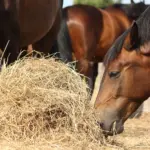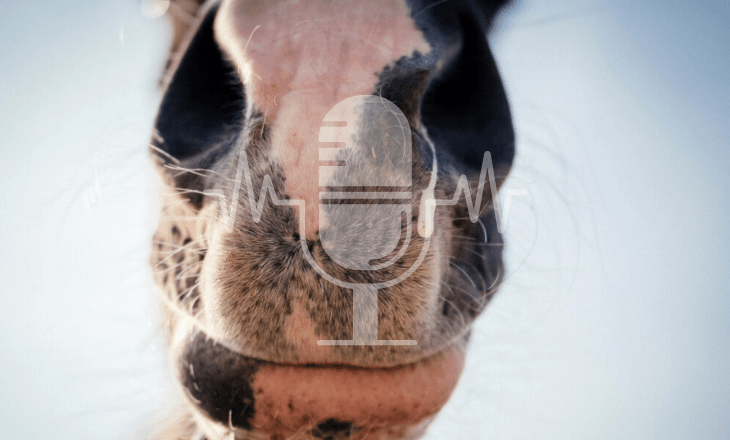Key Points at a Glance
- Forced feed breaks stress horses: withholding hay/forage runs counter to their evolution as near-continuous grazers and can lead to stress and aggression.
- Social challenges within the herd: lower-ranking horses are often pushed away from automatic feeders, and one-at-a-time feeding prevents the important social behaviour of eating together.
- Compromised intake: at automatic feeders, horses often eat in haste and chew less thoroughly, which can adversely affect digestion.
- Limited appropriate use: automatic hay feeders are only really useful with very nutrient-rich hay for targeted supplementary feeding of individual horses.
- Multiple automatic hay feeders: such systems only work if at least one feeder is always open, ensuring hay is available at all times.
- High cost for questionable benefit: at £1,000–£8,000 per unit, the outlay is rarely justified given the downsides.
- Better alternatives: Regulating eating speed via hay quality (based on forage analysis) and using haynets/slow-feeder nets is usually more horse-friendly.
Why automated hay feeding is often problematic
Feeding horses like machines to a fixed timetable may sound appealing—especially in an age of overweight horses, as it seems to promise tighter control over calorie intake. In reality, most automatic feeding systems originate in cattle farming, where precise nutrient requirements are defined for different breeds and physiological stages (growth, pregnancy or lactation) and rations are costed to the penny. Because cows naturally alternate periods of eating with periods of rumination, tightly time-limited access to forage works reasonably well for them.
Yet, in practice on horse yards, automated hay-feeding systems often create more problems than they solve. Research shows that horses using these feeders are more stressed, display more aggressive behaviour, and actually consume more forage.
The root of the problem lies in equine biology. Over millions of years of evolution, horses have developed a simple programme: a lack of forage signals a threat to survival. When automatic systems remove hay at set times, they trigger stress responses—seen as hurried, anxious eating, aggression towards other horses, and restless behaviour.
What’s more, chewing activity deteriorates markedly. Horses that realise the feed will soon be taken away tend to bolt it. The essential, slow breakdown of forage with thorough salivation falls by the wayside, which can lead to digestive upsets and weight gain. People then often try to compensate by shortening feeding windows further and lengthening the gaps—resulting in even more stress, aggression and feed-bolting. In short, with horses you end up with almost the exact opposite of what automatic hay feeders are meant to achieve.
In yards that use automatic single-horse feeding systems, rank issues can be dramatically amplified. Lower-ranking horses are often pushed away from the feeders by dominant herd members. While higher-ranking animals can access their rations without difficulty, the weaker ones are frequently left hungry.
This problem is compounded by the high purchase cost of the systems. As most yards can only afford a limited number of units, bottlenecks are inevitable. One feeder shared by three or four horses inevitably fuels competition and stress. Even if you programme it so a single access point allows 30 minutes per horse, four horses still mean a two-hour cycle—leaving each horse with a 90-minute wait before it can reach the hay again. These enforced gaps are highly stressful for horses.
The social aspect of eating together is also completely lost with single-horse feeders. Horses are herd animals that naturally graze as a group; close companions will often eat nose-to-nose. This behaviour strengthens bonds and fosters a relaxed atmosphere. Isolated, one-at-a-time feeding disrupts these natural patterns and can lead to behavioural problems and social friction within the group.
Automatic hay feeders: only sensible under specific conditions
Auto-closing hay feeders are often marketed as the perfect alternative to single-horse stations, combining timed feeding with the option for several horses to eat at once. These systems can work — but only under very specific circumstances. The most important requirement is permanent forage availability. In practice, that means a yard needs enough automatic feeders so that there are always some open, providing sufficient feeding places for every horse while others are closed.
A workable set-up could look like this: For four horses, install two automatic hay feeders, each with eight feeding places, that open and close in alternating phases. As one feeder closes, the other opens at the same time. This ensures hay is always available, while eating speed is moderated because the horses must move back and forth between the feeders.
However, the costs for such a set-up are considerable. With purchase prices of £1,500–£3,000 per automatic feeder, you’re quickly at £3,000–£6,000 for a four-horse group. On top of that come the costs of getting power to the feeders, which can be substantial depending on the site. For an open-group of 15–20 horses, the number of required feeders (plus space, cabling, etc.) rises accordingly. For most yards, this level of investment simply isn’t economically feasible.
Automatic hay feeders: only suitable for targeted top-up feeding
Single automatic hay feeders have their place — but only in very limited situations. They work only if you use very nutrient-rich hay for targeted supplementary feeding of individual horses, while the base forage remains permanently available in ordinary, always-open racks.
Typical use cases include poor doers that need extra energy, or competition horses in intensive work. In these cases, the feeder dispenses small amounts of nutrient-dense hay in addition to the basic ration. The regular, lower-energy hay must remain freely accessible at all times.
This set-up requires two different hay types and a carefully thought-out feeding strategy, plus switched-on yard staff who know exactly which bale goes where. You’ll need nutrient analyses for every batch of hay and the storage space to keep them separate. For most private owners this level of effort isn’t practical, and even for many livery yards it simply doesn’t stack up financially.
Better alternatives: hay quality and haynets
Rather than installing costly machines, you’ll get better results by choosing the right hay and using haynets. Low-energy (meadow) hay can be available at all times in large-mesh nets (so it doesn’t blow around the yard) without horses piling on weight.
Forage analysis of the hay gives precise figures for energy and protein. On that basis, you can select the right hay quality for each group of horses. Haynets with an appropriate mesh size naturally slow intake and regulate chewing—without creating stress. Horses have to chew for longer, engage more with the forage, and naturally take in smaller amounts at any one time. Different mesh sizes let you tailor intake to each horse’s needs and are a much more economical solution.

Cost comparison
The upfront cost of automatic hay-feeding systems is substantial. Simple timer-controlled racks typically run from £1,000(DIY) up to £3,000, while microchip-controlled units cost £3,000–£8,000 per unit. Installation, ongoing maintenance and repairs add further expense.
By contrast, high-quality haynets cost between £40 and £150 each and will last for several years. A hay analysis comes in at £80–£120 and gives you data for the entire batch. The cost difference is dramatic—so is the impact on the horses’ mental and physical well-being.
The “low-tech” option also avoids ongoing costs: no electricity, no maintenance contracts, no pricey spare parts. Good haynets are robust, weather-resistant and virtually indestructible.
When technology can still make sense
There are indeed situations where automatic systems have their place. Large yards with many horses—and a sufficient number of automatic hay feeders—can build workable set-ups in which some feeders are always open while others are closed, so the horses can’t simply ‘park’ at a rack all day.
In track systems, an automatic hay rack at the far end of the track—filled only with particularly nutrient-dense, extra-tasty hay and opened at random intervals for short periods—can significantly increase the herd’s movement. Sweet hay is a real incentive, even for lazy good-doers. The crucial point, as ever, is that low-energy forage remains available at all times.
Automatic feeders can also be helpful in rehabilitation or for horses with specific medical needs. If a horse requires precisely measured amounts of special hay at set times—while ordinary forage stays permanently available—an automatic feeder can be a sensible option.
When making the decision, be honest with yourself: is it truly about the horses’ welfare, or mainly about saving labour? Keeping horses requires frequent, hands-on contact with them every day — and that’s as it should be.
If you decide to go ahead with automatic systems despite the caveats, budget realistically. Beyond the purchase price, you will face costs for foundations, electrical connection, and often structural alterations to the stable/yard. Professional installation by specialist contractors typically adds £500–£1,500 per unit. You may also need planning permission and, in some cases, mitigation/offsetting measures.
Ongoing costs shouldn’t be underestimated. Regular servicing, spare parts and occasional repairs add up over the years. Electronic components are vulnerable to moisture and dust—both commonplace in stables. Breakdowns in the middle of the night or at weekends do happen, so you will need a Plan B for feeding.
Many manufacturers offer service contracts at £200–£500 per year. Factor these in from the start, as modern systems are rarely suitable for DIY fixes. And don’t forget rising electricity costs.
A critical appraisal is needed
Automatic hay-feeding systems are often marketed as a solution for modern horse management, but they bring a host of problems. They ignore horses’ natural need for constant forage availability and for eating together as a herd. The result is frequently stress, aggression and health issues.
Before investing in costly technology, take a hard look at the alternatives. With the right hay quality and simple haynets you can usually achieve better results at far lower cost. The money saved could be put to better use on high-quality hay or other aspects of horse keeping, such as a well-designed track system.
If automatic systems are used at all, they should only be combined with permanent forage availability and sufficient feeding places. Anything else does more harm than good.
- Automated hay feeding in the stable - 22. October 2025
- Automatic hard-feed dispensers in equine management - 22. October 2025
- Podcast #8 – When the Cold Wave Hits Your Barn: How to Help Horses with Colds and Respiratory Infections - 9. October 2025










